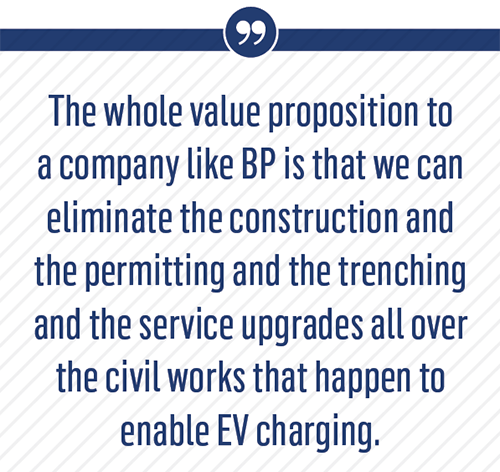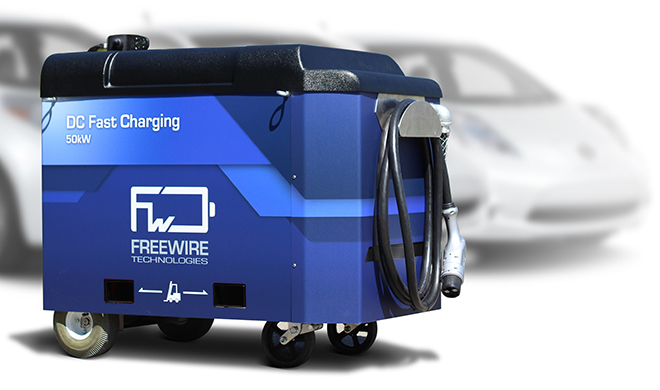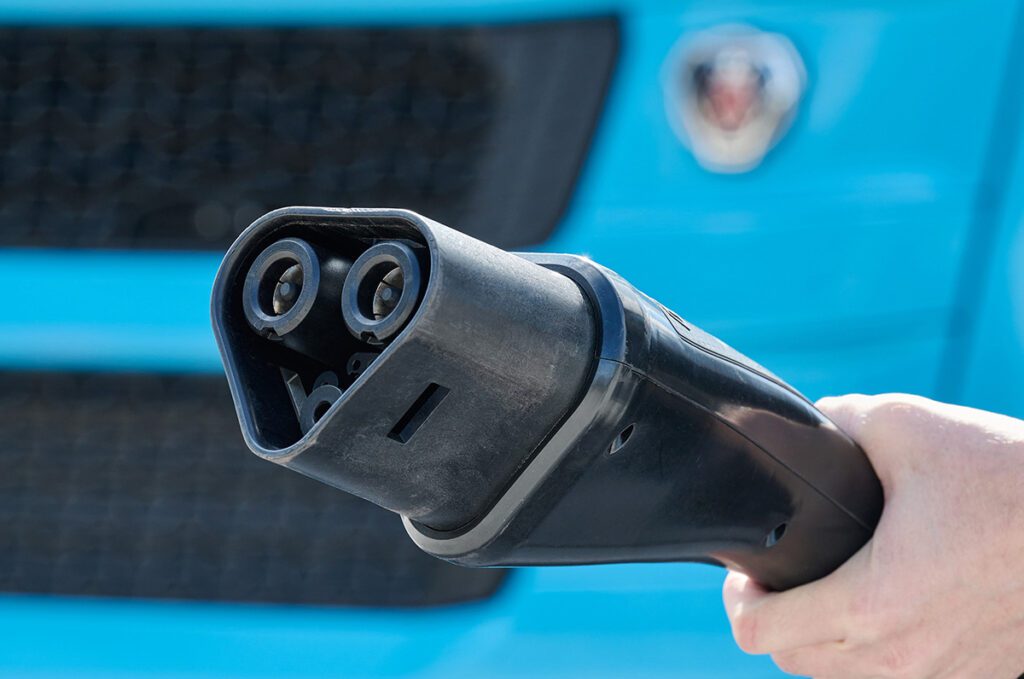Rolling out the charging stations necessary to enable wide-scale adoption of EVs is a challenging task. Though valiant efforts are being made, there are still a lot of problematic applications that could benefit from innovative solutions. One young company, FreeWire Technologies, believes it has an answer to help with scalability: batteries on wheels.
Business school and the problem with infrastructure
“If you’re trying to do scalable EV charging, you want to somehow mitigate infrastructure,” explains Arcady Sosinov, CEO of FreeWire. Born just outside Chernobyl, mere weeks after the infamous 1986 power plant explosion, Sosinov has an understandable fascination with energy. This fascination led him on the path to starting FreeWire in 2014.
The seeds of the company can be traced back to the University of California, Berkeley, where Sosinov was doing a part-time MBA. He was fortunate to encounter a professor named Steve Blank, an entrepreneur who specializes in startups (Blank has written four well-known books on the topic, including The Four Steps to the Epiphany and The Startup Owner’s Manual).
Blank’s course at UC Berkeley, called the Lean Launchpad, prompted Sosinov to begin researching the problems with EV charging.
“It was a ten-week course on customer discovery,” recalls Sosinov. “And so I formed this company FreeWire around a singular idea, which was to make EV charging more scalable. So we were just going out and trying to figure out pain points around scalable EV charging. And over the ten weeks, I talked to anyone and everyone who was doing charging in the Bay area. We met 120 people in this industry over ten weeks, and I figured it out. People were having trouble involving infrastructure. The grid edge was not able to support EVs as they scale.”
Sosinov realized that building the necessary infrastructure was always going to be a bottleneck. His idea for a solution turned out to be surprisingly simple: instead of EVs going to a charger, why not have the charger come to the EVs?
“On the very last day of that class we unveiled this rudimentary minimum viable product that we built,” Sosinov said. “It was a battery system on wheels that was remote controlled and could charge a car. And that day we charged Steve Blank’s Tesla. It was the first time we had ever charged a Tesla, and it worked. And – long story short – he became our first angel investor, and the company developed since then.”

FreeWire develops and tech companies line up
Once he was finished with the Lean Launchpad course, Sosinov decided to pursue his company full-time. Based on FreeWire’s success since then, it seems clear he made the right call.
“Over the last four years it’s evolved pretty dramatically,” Sosinov said. “We’re not a few people out of a garage anymore in business school, we’re now about 32 people in an engineering and manufacturing technology space in the Bay area.”
What do these 32 people do today? Here’s how Sosinov describes his company: “We are a system manufacturer designing products and services to make electrification easier. We take cells, we combine them with power electronics, with control systems, with a communication platform, all safety equipment, and pack that into a nice form factor. It’s a neat, all-in-one, really space-efficient solution that eliminates the challenges of traditional infrastructure.”
FreeWire it produces the mobile battery pack system, and also operates service models with its hardware. In 2015, FreeWire conducted a pilot program of what is today one of its most successful applications. The company launched a three-month test with LinkedIn, providing EV charging to employees at the company’s Mountain View campus. Three months later, LinkedIn became FreeWire’s first commercial contract.

Here’s how it works: FreeWire dispatches several of its mobile battery packs to a campus, along with a service attendant. When employees drive into the parking lot, they simply open FreeWire’s mobile app and request a charge. When they leave at the end of the day, they find their batteries full. It really is that easy.
The advantages of this approach are numerous. The employees are happy that they can reliably get a charge. The facility manager is happy not to deal with complaints about charging spaces. And the company is happy to spend less money on on-demand electricity charges, as FreeWire eliminates the peaks of energy consumption that can happen around 9:00 AM and 1:00 PM when everyone plugs in at the same time.

Today, FreeWire offers this same service to many of the largest tech companies in the Bay area. Often, these companies offer charging as a perk to their employees. Some charge the drivers for the service, though it’s generally subsidized. For this service model to work, FreeWire recommends at least 30 vehicles should require charging every day. Its biggest customer charges 60 vehicles per day.
Utilities, entertainment and construction
Providing charging services to tech companies in the Bay area is only part of FreeWire’s business. About half of its revenue comes from partnering with utilities. BP, Hawaiian Electric, Southern California Edison, the Los Angeles Department of Water and Power, Vector and others have seen the value of FreeWire’s solution.
As an example, Sosinov described the solutions FreeWire is deploying with BP in London.

“We’re deploying our Mobi Chargers at select BP gas stations (‘forecourts’ in the UK),” Sosinov said. “Fossil fuel giants are recognizing customer needs and looking ahead to the electric future of mobility by opening up to new EV charging solutions.”
Why would BP want to use mobile charging solutions on its forecourts, rather than building permanent infrastructure?
“The whole value proposition to a company like BP is that we can eliminate the construction, the permitting, the trenching, the service upgrades and all the other civil works that happen to enable EV charging,” Sosinov explained. “Civil works on a gas station are actually significantly harder and more expensive than in most other places. So if you want to turn a gas station into an EV charging facility, you’re going to need to either put money into construction and civil works or buy technology solutions to try and mitigate that.”

FreeWire had no trouble identifying other markets that could benefit from a mobile power solution, and quickly zeroed in on diesel generators – a “ubiquitously hated product” in Sosinov’s words.
“Customers don’t like diesel generators,” he said. “They don’t like the fumes, they don’t like the noise, and there are regulations coming down making it even harder to permit diesel generators. So it became kind of a natural fit for us.”
FreeWire struck a deal with Stanley Black & Decker, a large tool company, to deploy its mobile power systems in the industrial equipment rentals space. FreeWire’s mobile battery packs are used as alternatives to diesel generators in the entertainment and construction industries.
Outside of these industries, FreeWire has contributed its mobile power solutions to a variety of good causes.
“We’ve also done some other really heartfelt and interesting things,” Sosinov said. “We worked with the Red Cross to power blood banks. We have worked with Off the Grid, which is a food truck market here in San Francisco, to power its food trucks. So there are a lot of really interesting and impactful use cases, although the biggest market of course is still rental of these systems for industries like construction and entertainment.”
Finally, FreeWire has started collaborating with automotive OEMs, though Sosinov is reticent about giving details. “I would get my hand slapped if I talked about that,” he jokes. “But we are working with one of the major OEMs on a pretty significant pilot around on-demand EV charging. That’s pretty much all I can say.”

The future of FreeWire
Today, FreeWire’s mobile EV chargers operate at 50 kW, which is fairly standard in the EV space. One huge advantage of FreeWire’s solutions, according to Sosinov, is that they can easily scale to higher charging speeds.
“What we’re inherently doing is slow charging from the grid, putting in a full battery pack, and then there’s a DC-DC bridge from our battery pack to the car’s battery pack,” Sosinov said. “And that DC-DC can scale to high power rates pretty easily. So once cars support it, you’ll see much higher charging rates from us.”
Like its power packs, FreeWire is also ready to go the next level. While its biggest market is in California, the company has already started to expand. It has a customer each in Tokyo and New Zealand, and will be deploying in London with BP this quarter.
“The way I see the business model is 50/50 going forward,” Sosinov said. “There will be large organizations that want to buy [battery packs] and manage their fleets. And we have created a version of our software platform that allows customers to manage a fleet as long as they own that fleet. But there will be about half of our customers in which we manage the fleet for them. And we own that capacity, and we can do what we need to with it, which allows us to do some really interesting things in the future in terms of utility-facing business models. Ultimately, we want to keep solving infrastructure hurdles and deliver energy whenever, wherever it’s needed for reliable electrification beyond the electrical grid.”
This article originally appeared in Charged Issue 38 – July/August 2018 – Subscribe now.










































































































